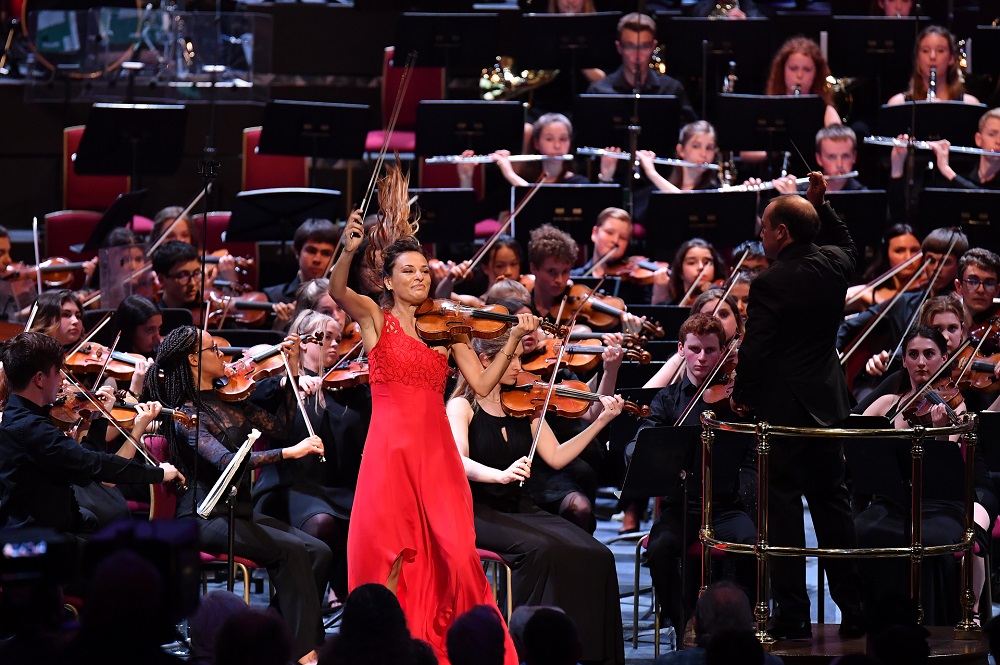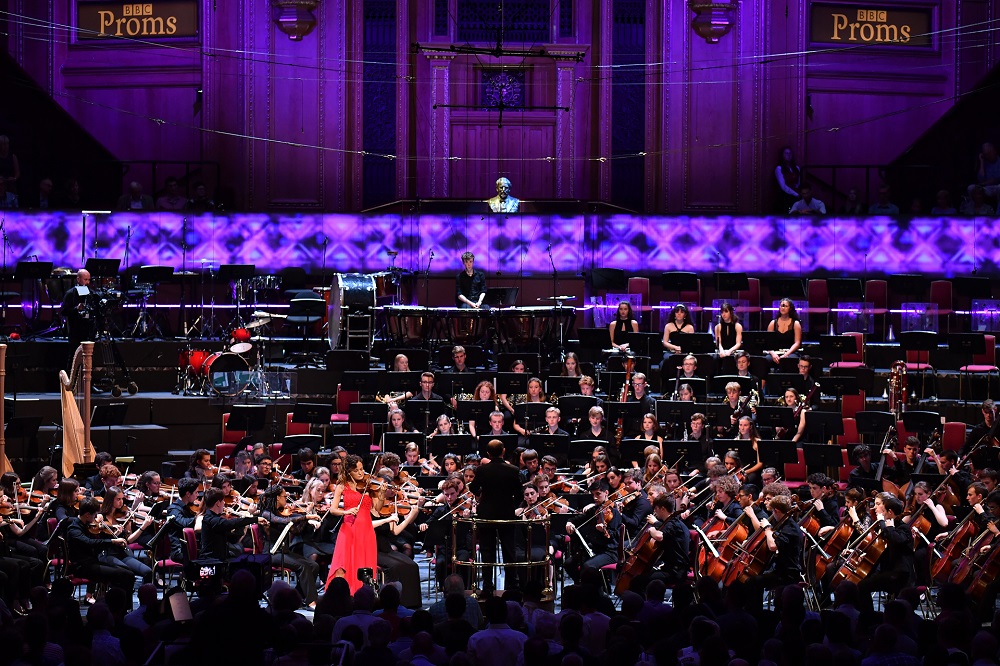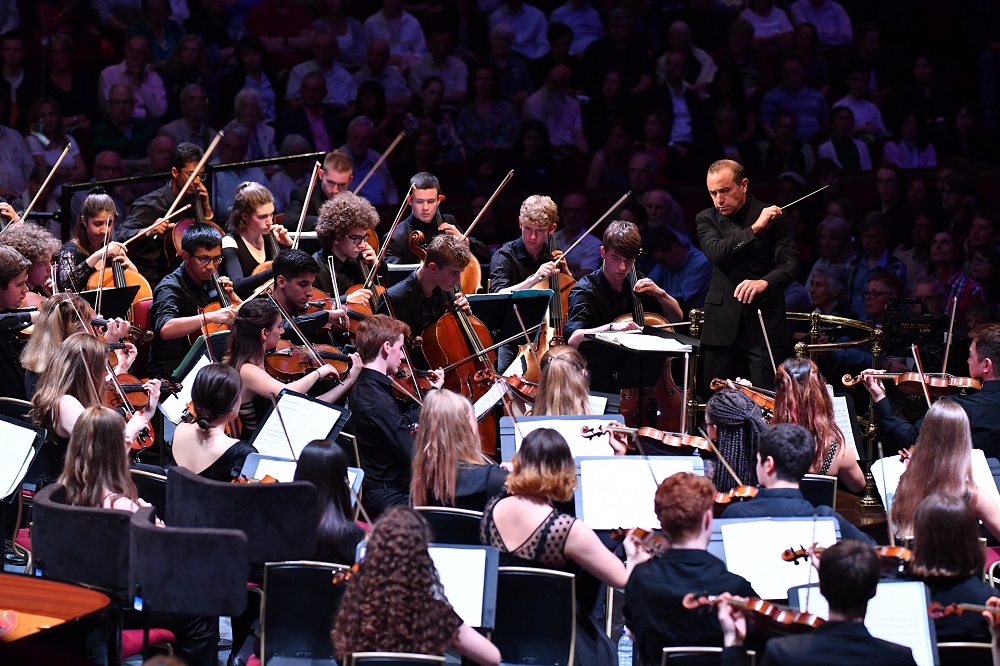Prom 12: Benedetti, National Youth Orchestra of Great Britain, Wigglesworth - adrenalin highs and string sound to die for | reviews, news & interviews
Prom 12: Benedetti, National Youth Orchestra of Great Britain, Wigglesworth - adrenalin highs and string sound to die for
Prom 12: Benedetti, National Youth Orchestra of Great Britain, Wigglesworth - adrenalin highs and string sound to die for
164 teenagers burn for two inspiring mentors in spectacular Russian programme
In the Netherlands, Mark Wigglesworth is already a musical legend for his work with Dutch youth orchestras. Hopefully, in addition to the year and a bit when he wrought miracles at English National Opera, he will become so in the UK after his training of the National Youth Orchestra of Great Britain. That culminated in last night's Prom, with more than a little help from co-inspirer Nicola Benedetti.
By then, the adrenalin and concentration had been flowing through three remarkable interpretations. The start was as visceral as the unofficial finish, wood snapping on strings as Chelyabinsk-born Lera Auerbach’s Icarus flapped wildly in mid-air before biting the dust (“Humum mundere”, as the NYO’s programme but not the Proms’ tells us, is the title of the opening sequence). What refreshment to hear original melodic lines from a contemporary composer; and what a connection to the tragic end of Prokofiev's second-half Shakespearean narrative with the mesmerising final ritual of “Requiem for Icarus”. 
She then gave them and us a treat with the wayward folksy wistfulness of "As the Wind Goes", second movement of the Fiddle Dance Suite written for her by Wynton Marsalis, walking off the platform to infinity at the end (the last time I witnessed that was in the premiere of Matt Kaner’s Stranded at the 2017 Europe Day Concert in St John's Smith Square, when violinist Benjamin Baker's breaking away was a symbolic gesture of the self-harm the UK may still do itself). 
No doubt, though, about the urgency and continuity of the performance. We plunged into the violence of Montagues and Capulets in another suite synthesis before Wigglesworth reverted entirely to the full ballet score, giving us the dance-into-fight sequence from Act One, violins hell-for-leather in combat as if they were the section of the Berlin Philharmonic. 
rating
Share this article
Add comment
The future of Arts Journalism
You can stop theartsdesk.com closing!
We urgently need financing to survive. Our fundraising drive has thus far raised £49,000 but we need to reach £100,000 or we will be forced to close. Please contribute here: https://gofund.me/c3f6033d
And if you can forward this information to anyone who might assist, we’d be grateful.

Subscribe to theartsdesk.com
Thank you for continuing to read our work on theartsdesk.com. For unlimited access to every article in its entirety, including our archive of more than 15,000 pieces, we're asking for £5 per month or £40 per year. We feel it's a very good deal, and hope you do too.
To take a subscription now simply click here.
And if you're looking for that extra gift for a friend or family member, why not treat them to a theartsdesk.com gift subscription?
more Classical music
 From Historical to Hip-Hop, Classically Black Music Festival, Kings Place review - a cluster of impressive stars for the future
From quasi-Mozartian elegance to the gritty humour of a kitchen inspection
From Historical to Hip-Hop, Classically Black Music Festival, Kings Place review - a cluster of impressive stars for the future
From quasi-Mozartian elegance to the gritty humour of a kitchen inspection
 Shibe, LSO, Adès, Barbican review - gaudy and glorious new music alongside serene Sibelius
Adès’s passion makes persuasive case for the music he loves, both new and old
Shibe, LSO, Adès, Barbican review - gaudy and glorious new music alongside serene Sibelius
Adès’s passion makes persuasive case for the music he loves, both new and old
 Anja Mittermüller, Richard Fu, Wigmore Hall review - a glorious hall debut
The Austrian mezzo shines - at the age of 22
Anja Mittermüller, Richard Fu, Wigmore Hall review - a glorious hall debut
The Austrian mezzo shines - at the age of 22
 First Person: clarinettist Oliver Pashley on the new horizons of The Hermes Experiment's latest album
Compositions by members of this unusual quartet feature for the first time
First Person: clarinettist Oliver Pashley on the new horizons of The Hermes Experiment's latest album
Compositions by members of this unusual quartet feature for the first time
 Gesualdo Passione, Les Arts Florissants, Amala Dior Company, Barbican review - inspired collaboration excavates the music's humanity
At times it was like watching an anarchic religious procession
Gesualdo Passione, Les Arts Florissants, Amala Dior Company, Barbican review - inspired collaboration excavates the music's humanity
At times it was like watching an anarchic religious procession
 Classical CDs: Camels, concrete and cabaret
An influential American composer's 90th birthday box, plus British piano concertos and a father-and-son duo
Classical CDs: Camels, concrete and cabaret
An influential American composer's 90th birthday box, plus British piano concertos and a father-and-son duo
 Cockerham, Manchester Camerata, Sheen, Martin Harris Centre, Manchester review - re-enacting the dawn of modernism
Two UK premieres added to three miniatures from a seminal event of January 1914
Cockerham, Manchester Camerata, Sheen, Martin Harris Centre, Manchester review - re-enacting the dawn of modernism
Two UK premieres added to three miniatures from a seminal event of January 1914
 Kempf, Brno Philharmonic, Davies, Bridgewater Hall, Manchester review - European tradition meets American jazz
Bouncing Czechs enjoy their Gershwin and Brubeck alongside Janáček and Dvořák
Kempf, Brno Philharmonic, Davies, Bridgewater Hall, Manchester review - European tradition meets American jazz
Bouncing Czechs enjoy their Gershwin and Brubeck alongside Janáček and Dvořák
 Solomon, OAE, Butt, QEH review - daft Biblical whitewashing with great choruses
Even a top soprano and mezzo can’t make this Handel paean wholly convincing
Solomon, OAE, Butt, QEH review - daft Biblical whitewashing with great choruses
Even a top soprano and mezzo can’t make this Handel paean wholly convincing
 Two-Piano Gala, Kings Place review - shining constellations
London Piano Festival curators and illustrious friends entertain and enlighten
Two-Piano Gala, Kings Place review - shining constellations
London Piano Festival curators and illustrious friends entertain and enlighten
 Echo Vocal Ensemble, Latto, Union Chapel review - eclectic choral programme garlanded with dance
Beautiful singing at the heart of an imaginative and stylistically varied concert
Echo Vocal Ensemble, Latto, Union Chapel review - eclectic choral programme garlanded with dance
Beautiful singing at the heart of an imaginative and stylistically varied concert
 Scott, Irish Baroque Orchestra, Whelan, RIAM, Dublin review - towards a Mozart masterpiece
Characteristic joy and enlightenment from this team, but a valveless horn brings problems
Scott, Irish Baroque Orchestra, Whelan, RIAM, Dublin review - towards a Mozart masterpiece
Characteristic joy and enlightenment from this team, but a valveless horn brings problems

Comments
I listened to the broadcast
Strictly speaking, yes, the
Strictly speaking, yes, the Knights' Dance appears in the Capulet ball. But in one of the suites, preceded by 'the Duke's Command', it is called 'Montagues and Capulets' and stands for the violence between the clans, which is why Wigglesworth chose it as the starter. So, this time loosely speaking, he did 'stick to the plot'. And there was no 'chunk of it there (up to Juliet's solo)' - that was all fight music from Act One.
Even though the first page of
Now you're being pedantic,
Now you're being pedantic, and if one is pedantic in return, you're wrong. The version Wigglesworth used was the movement from the suite (the orchestrataion is different). Both the fact that he chose to begin with it and the faster tempo he took, which you didn't like and which I would argue conveys a more general violence than the striding of 'Dance of the Knights' in the ballet, points to his intention to give the love story the turbulent context of warring clans.
You have certainly confirmed
Hardly challenged. I reasoned
Hardly challenged. I reasoned, you ignored. There are certain facts which can't be denied. Though I granted initially that, strictly speaking, there was some music from the Capulet ball.